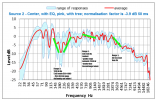TheZebraKilledDarwin
Active Member
- Joined
- Apr 19, 2023
- Messages
- 173
- Likes
- 138
Let's assume a well calibrated, good sounding setup with well controlled acoustics, a flat frequency response, maybe even gently sloped to a finely crafted house curve.
Despite a good system - according to measurements - maybe some are familiar with one of these sound anomalies:
- While the setup is sounding great with music, but a chainsaw, a jet turbine, or a sword hitting metal in a movie can hurt in the ears and sound not as good as in the theatre.
- The sound of loud shouting women, shouting crowds, hurting the ears. The midrange does not "knock" like in good sounding theatres and voices somehow lack the warmth. Maybe you even tried to warm up the voices by boosting lower mids, but it resulted in muddying the sound.
- Despite a sufficiently flat FR without strong peaks, lower male voices sometimes sound too muffled, but the bass isn't too loud.
Here is the frequency response of a Dubbing Stage:
(Dubbing stage E, from: Frequency Response Analysis of Theatres and Dubbing Stages by the Society of Motion Picture and Television Engineers (SMPTE))
What do you see?
Probably a not very impressively looking frequency response.
And here's what I see:
Interestingly, this is the frequency response difference with Auro 2D enabled vs Auro off (Center speaker):
The other speakers were not disconnected, so there is also the influence from the crosstalk of the ambience program and probably some comb filtering.
Every setup is different just like tastes, but some things are noticeable in all of these:
The relatively loud 500 Hz range. Our ear is so incredibly sensible in the 1k eare, that even a change of 1 dB of the balance between the 1 kHz vs 500 Hz range, is audible. So while we may look at a perfectly flat frequency response, you want to pay attention to the RELATIVE balance of that hugely important range.
If you sometimes get pain from high shouting voices, and the 500 Hz range measures less loud than the 1k or 1.2k, then you might want to get this balance changed.
I recommend to use 1/3rd octave smoothing to see, what we hear - but I recommend to use a higher resolution, to see the exact frequency of potentially present narrow peaks.
In general a more broad EQing is preferrable, over a narrow one, but to change that balance, a narrow EQing might be unavoidable.
When I implemented the dip around the 200 Hz range, it immediately reminded me soundwise of the "Pulteq trick" (boosting and cutting at the same time, but the cut has a more narrow band and is slightly higher; this "trick" results in a perceived stronger bass boost, without really boosting much and it has the benefit of boosting bass without increasing muddyness). It surprised me, how strongly the bass perception benefits from that dip without any negative side effects on the low midrange.
Last but not least, the 3k vs 4k region:
My setup had measured equally loud 4k after Audyssey. And it was always a painful experience. All the Audyssey and Cinema EQ things did not work.
After seeing the SMPTE measurements I understood. The theatrical sound has a much more subdued 4k range.
Getting the 4k range a few dBs down below the 2.8-3k range was like being relieved from pain.
To avoid the sound from becoming too dull, I did not follow an x-curve for the higher treble range above 5k (interestingly the Auro 2D EQ also showed this behaviour in my measurement).

